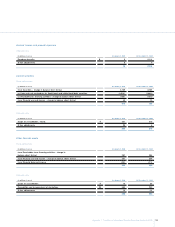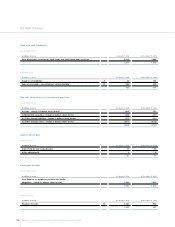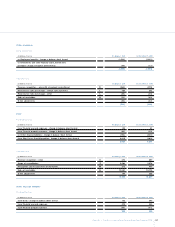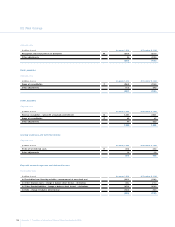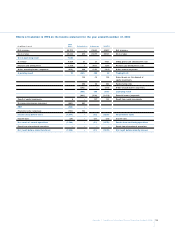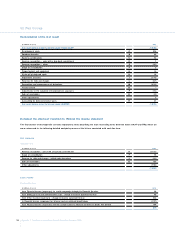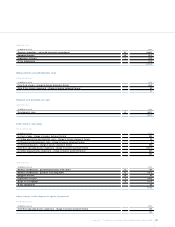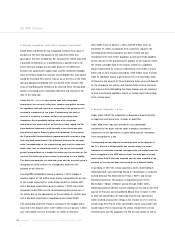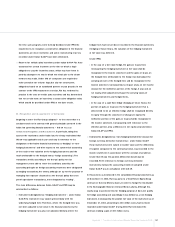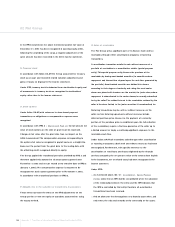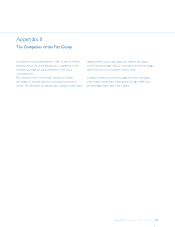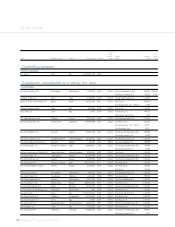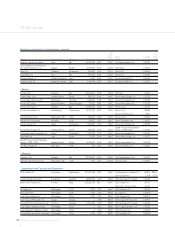Chrysler 2005 Annual Report Download - page 165
Download and view the complete annual report
Please find page 165 of the 2005 Chrysler annual report below. You can navigate through the pages in the report by either clicking on the pages listed below, or by using the keyword search tool below to find specific information within the annual report.
164 Appendix 1 Transition to International Financial Reporting Standards (IFRS)
02 Fiat Group
D. Revenue recognition - sales with a buy-back commitment
Under Italian GAAP, the Group recognised revenues from sales of
products at the time title passed to the customer, which was
generally at the time of shipment. For contracts for vehicle sales with
a buy-back commitment at a specified price, a specific reserve for
future risks and charges was set aside based on the difference
between the guaranteed residual value and the estimated realisable
value of vehicles, taking into account the probability that such option
would be exercised.This reserve was set up at the time of the initial
sale and adjusted periodically over the period of the contract.The
costs of refurbishing the vehicles, to be incurred when the buy-back
option is exercised, were reasonably estimated and accrued at the
time of the initial sale.
Under IAS 18 – Revenue, new vehicle sales with a buy-back
commitment do not meet criteria for revenue recognition, because
the significant risks and rewards of ownership of the goods are not
necessarily transferred to the buyer. Consequently, this kind of
contract is treated in a manner similar to an operating lease
transaction. More specifically, vehicles sold with a buy-back
commitment are accounted for as Inventory if they regard the Fiat
Auto business (agreements with normally a short-term buy-back
commitment) and as Property, plant and equipment if they regard
the Commercial Vehicles business (agreements with normally a long-
term buy-back commitment).The difference between the carrying
value (corresponding to the manufacturing cost) and the estimated
resale value (net of refurbishing costs) at the end of the buy-back
period, is depreciated on a straight-line basis over the duration of the
contract.The initial sale price received is accounted for as a liability.
The difference between the initial sale price and the buy-back price is
recognised as rental revenue on a straight-line basis over the
duration of the contract.
O pening IFRS stockholders’ equity at January 1, 2004 includes a
negative impact of 180 million euros mainly representing the portion
of the margin accounted for under Italian GAAP on vehicles sold
with a buy-back commitment prior to January 1, 2004, that will be
recognised under IFRS over the remaining buy-back period, net of
the effects due to the adjustments to the provisions for vehicle sales
with a buy-back commitment recognised under Italian GAAP.
This accounting treatment results in increases in the tangible assets
reported in the balance sheet (1,001 million euros at January 1, 2004
and 1,106 million euros at December 31, 2004), in inventory
(608 million euros at January 1, 2004 and 695 million euros at
December 31, 2004), in advances from customers (equal to the
operating lease rentals prepaid at the date of initial sale and
recognised in the item O ther payables), as well as in Trade payables,
for the amount of the buy-back price, payable to the customer when
the vehicle is bought back. In the income statement, a significant
impact is generated on revenues (reduced by 1,103 million euros in
2004) and on cost of sales (reduced by 1,090 million euros in 2004),
while no significant impact is generated on the net operating result;
furthermore, the amount of these impacts in future years will depend
on the changes in the volume and characteristics of these contracts
year-over-year. N otwithstanding this, these changes are not expected
to have a particularly significant impact on Group reported earnings
in the coming years.
E. Revenue recognition – Other
Under Italian GAAP the recognition of disposals is based primarily
on legal and contractual form (transfer of legal title).
Under IFRS, when risks and rewards are not substantially
transferred to the buyer and the seller maintains a continuous
involvement in the operations or assets being sold, the transaction
is not recognized as a sale.
Consequently, certain disposal transactions, such as the disposal of
the 14% interest in Italenergia Bis and certain minor real estate
transactions, have been reversed retrospectively:the related asset has
been recognised in the IFRS balance sheet, the initial gain recorded
under Italian GAAP has been reversed and the cash received at the
moment of the sale has been accounted for as a financial liability.
In particular, in 2001 the Group acquired a 38.6% shareholding in
Italenergia S.p.A., now Italenergia Bis S.p.A. (“Italenergia”), a company
formed between Fiat, Electricité de France (“EDF”) and certain
financial investors for the purpose of acquiring control of the
Montedison - Edison (“Edison”) group through tender offers.
Italenergia assumed effective control of Edison at the end of the third
quarter of that year and consolidated Edison from O ctober 1, 2001.
In 2002 the shareholders of Italenergia entered into agreements
which resulted, among other things, in the transfer of a 14% interest
in Italenergia from Fiat to other shareholders (with a put option that
would require Fiat to repurchase the shares transferred in certain
circumstances) and the assignment to Fiat of a put option to sell its



